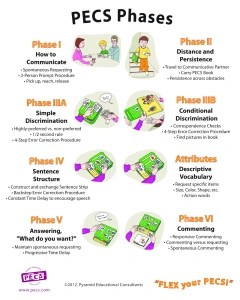Blog
Picture Exchange Communication System (PECS)
The Picture Exchange Communication System or PECS approach was developed by Andrew Bondy and Lori Frost in 1985 and is a modified applied behavior analysis program designed for early nonverbal symbolic communication training. It is not a program designed to teach speech, although the latter is encouraged indirectly and some children begin to spontaneously use speech while enrolled in the PECS program.
PECS has been successful with a variety of populations including children with autism, those who have social-communicative and/or behavioral disorders, are non-verbal, and/or for those who are visual learners. It is important that from whatever target population the child belongs to, he or she can sit and attend to a two-dimensional stimulus and be able to physically hand each picture to his or her communication partner and establish joint attention.
The procedure for PECS intervention follows in a hierarchy of phases. PECS begins by teaching the child to give a picture of a desired item to a communication partner, who immediately honors the exchange as a request. The system goes on to teach discrimination of pictures and how to put them together to form phrases and sentences. In the more advanced phases, children are taught to respond to questions and spontaneously comment.
An outline of the phases are as follows:
 Phase I: How to Communicate- Students learn how to exchange single pictures for items or activities that they really want. It is important that the communication partner finds out what the child has interest in so that he or she isn’t prompted into asking for something they don’t like. We should never make PECS aversive.
Phase I: How to Communicate- Students learn how to exchange single pictures for items or activities that they really want. It is important that the communication partner finds out what the child has interest in so that he or she isn’t prompted into asking for something they don’t like. We should never make PECS aversive.
Phase II: Distance and Persistence- Still using single pictures, students learn to generalize this new skill by using it in different places, with different people and across distances. This phase is also utilized for the purpose of expanding spontaneity from the child.
Phase III: Picture Discrimination- Students learn to select from two or more pictures to ask for their favorite things. These favorite things are placed in a communication book- a three ring binder with Velcro strips where pictures are stored and easily removed for communication.
Phase IV: Sentence Structure- Students seek out their PECS board, and learn to construct simple sentences on a detachable sentence strip using an “I want” picture followed by a picture of the item being requested. Students then seek out a communicative partner, and give him or her the sentence strip. Listeners read the strip back to the child, inserting a fixed time delay between the words “I want” and the item label. Additional social praise is added if a child independently provides the label during the delay.
*Attributes and Language Expansion* At this point, students begin to learn to expand their sentences by adding adjectives, verbs, and prepositions.
Phase V: Answering a direct question- Students learn to use PECS to answer the question, “What do you want?”
Phase VI: Commenting- Now students are taught to comment in response to questions such as, “What do you see?”, “What do you hear?” and “What is it?” They learn to make up sentences starting with “I see,” “I hear,” “I feel,” “It is a,”etc.
Support provided by the clinician is included within each description of each phase; however, additional support and prompts may include:
Question Cues: “What do you want?”
Hand Over Hand Cues: Helping to initiate the movement of putting the pictures from the communication board onto the sentence strip or by helping rip off the pictures.
Visual Cues: Pointing to the pictures on the communication board.
PECS is supported by evidenced based practice, and has demonstrated enhanced communication skills in a variety of populations. It is important to note that a therapist should be PECS trained before implementing the approach.
Clink the link below to watch how Phase 1 of PECS is used. Thanks for reading!
References:
Ali, E., MacFarland, S. Z., & Umbreit, J. (2011). Effectiveness of combining tangible symbols with the picture exchange communication system to teach requesting skills to children with multiple disabilities including visual impairment. Education & Training in Autism & Developmental Disabilities, 46(3), 425-35.
Ganz, J., Lund, E., Simpson, R. The Picture Exchange Communication System (PECS): A Promising Method for Improving Communication Skills of Learners with Autism Spectrum Disorders. Education and Training in Autism and Developmental Disabilities, 2012, 47(2), 176-186.
The Picture Exchange Communication System (PECS). (n.d.). Retrieved October 18, 2015, from http://www.nationalautismresources.com/picture-exchange-communication-system.html
Amanda Weiner M.S. CF-SLP, TSSLD




